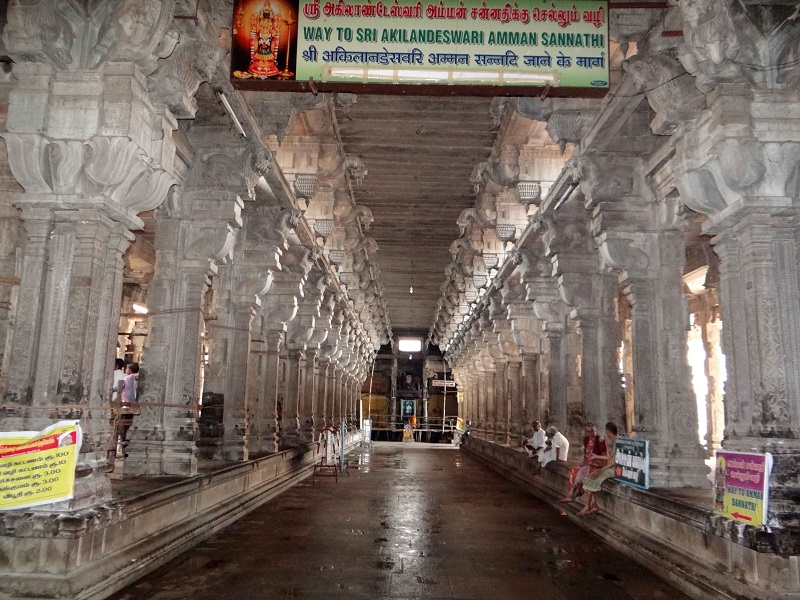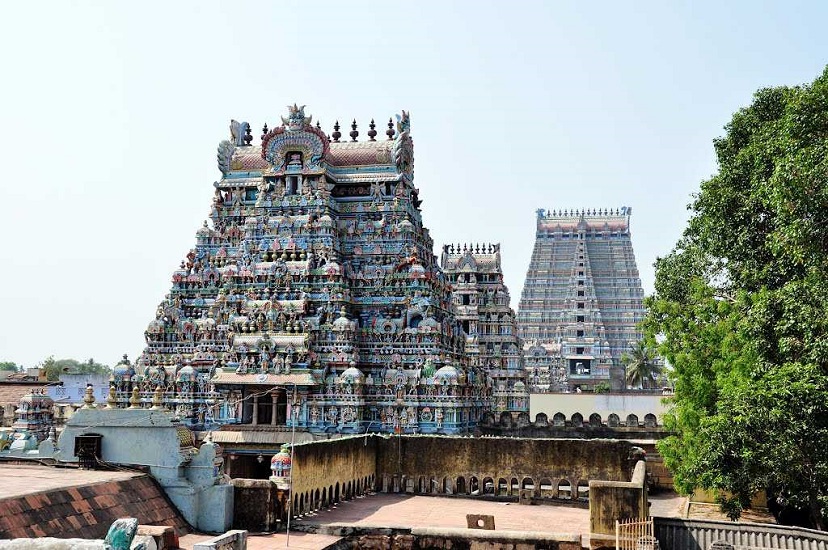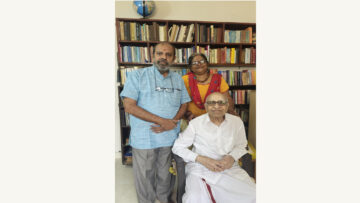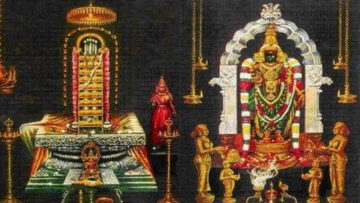Jambukeshwarar: Where the Divine Flows-Apas Tatva
ओङ्कारार्णवमध्यगे त्रिपथगे ओङ्कारबीजात्मिके
ओङ्कारेण सुखप्रदे शुभकरे ओकारबिन्दुप्रिये ।
ओङ्कारे जगदम्बिके शशिकले ओङ्कारपीठस्थिते
दासोऽहं तव पादपद्मयुगलं वन्देऽखिलाण्डेश्वरि ॥
Oṃ-kārārṇavamadhyagē tripathagē oṃ-kārabījātmikē |
Oṃ-kārēṇa sukhapradē śubhakarē oṃ-kārabindupriyē ||
Oṃ-kārē jagadambikē śaśikalē oṃ-kārapīṭhasthitē |
Dāsō’smi tava pādapadmayugalaṁ vandē akhilāṇḍēśvari ||
“O Akhilandeshwari, who abides in the ocean of Om, who moves through the threefold paths of knowledge, devotion, and action, who is the seed and essence of Om — through Om you grant joy, you bring auspiciousness, you delight in the bindu, the dot of Om. You are the World-Mother, adorned with the crescent moon, enthroned upon the seat of Om. I am but your servant, and I bow at your lotus feet.”
Akhilandeshwari is Omkāra-svarūpiṇī, the very embodiment of the primordial sound. She is the nurturing Mother, yet the crescent moon on her brow reminds us that even Mahadeva himself rests within her radiance. Transcendent and eternal, she is the primal source of creation. Beyond the roles of Mātā, Pitā, or Guru, she stands as Deivam — the Goddess Absolute. She is saguṇa, radiant and beautiful, yet also nirguṇa, beyond all attributes. Sovereign of the cosmos, she moves ceaselessly between her myriad forms — Ugra, fierce and intense, and Saumya, gentle and benign, who fulfils every prayer of her devotee. At Jambukeshwaram, she abides as the eternal consort of Jambukeshwara, the Āpas Liṅga, the embodiment of water.
It may seem unusual, in a series devoted to the Pancha Bhoota Sthalams of Shiva, to begin here with the Goddess rather than the Lord. Yet this is no aberration. At Jambukeshwaram, Akhilandeshwari does not stand in the shadow of Jambukeshwara; she shines forth in her own sovereignty. If at Chidambaram the focus is on space (ākāśa), at Tiruvannamalai on fire (agni), and at Kanchipuram on earth (pṛthvī), then here at Jambukeshwaram it is water (apas) that flows — and water is inseparable from the Divine Mother. It nurtures, nourishes, and sustains. It dissolves boundaries and carries life. The Goddess, in her very essence, is this unbounded flow.
Tradition remembers that Akhilandeshwari herself performed penance here, seeking the grace of Shiva, and that Ādi Śaṅkara, in his compassion, transformed her Ugra aspect into the ever-benign Mother we worship today. Thus this temple is not only the abode of the Āpas Liṅga but also the shrine where Devi reveals herself as Deivam — the cosmic Mother, transcending the categories of consort, disciple, or even sovereign.
And yet, even as she radiates in her independence, she remains inseparably linked with Jambukeshwara, the Lord of Water. For it was here, beneath the shade of a Jambu tree, that Parvati, as Akhilandeshwari, fashioned a Linga from the waters of the Kaveri. Pleased with her penance, Shiva revealed himself as Jambukeshwara. To this day, the sanctum bears witness to that miracle: water springs eternally from within, pooling at the base of the Linga. To stand at Thiruvanaikaval is to feel the pulse of Apas within oneself — the silent stream of compassion, emotion, and wisdom flowing endlessly through the human heart.
Among the many mysteries of Akhilāṇḍeśwarī at Thiruvanaikaval, none are as enduring as the tāṭaṅkas—the great circular ear-ornaments that she always wears. At first glance, they may seem like jewels adorning the Mother’s beauty, but to the initiated they are far more: yantras in visible form, bindus of concentrated śakti, holding within them the fierce radiance of the Goddess herself.
ताटङ्क-युगलीभूत-तपनोडुप-मण्डला ॥ २२ ॥
tāṭaṅka-yugalībhūta-tapanoḍupa-maṇḍalā || 22 ||
“She whose twin tāṭaṅkas (ear-ornaments) shine like the orbs of the Sun and the Moon.”
In ancient times, Akhilāṇḍeśwarī was worshipped here in her Ugra aspect. So intense was her gaze, tradition says, that few could stand before her without trembling. When Ādi Śaṅkarācārya came to this sthala, he perceived that her overflowing power needed to be gently harmonized—not diminished but transformed into the grace-filled form of a mother who could embrace all devotees. In his infinite wisdom, he consecrated two tāṭaṅkas, each inscribed with the Śrīvidyā mantra-śakti, and adorned them on the ears of the Goddess. From that moment on, her fiery glance was softened, and her boundless energy was absorbed into the luminous discs at her ears. Thus, Akhilāṇḍeśwarī became approachable to all, radiating compassion while still holding within her the immeasurable might of creation.
It is for this reason that the tāṭaṅkas of Thiruvanaikaval are not regarded as ornaments but as living embodiments of Śakti. Even today, devotees believe that to gaze upon them is to receive the blessings of harmony, fulfillment, and marital happiness. In fact, a well-known tradition holds that young women desiring marriage should sit before the Goddess and fix their eyes upon the tāṭaṅkas, allowing her grace to flow through them.
The sanctity of this practice was beautifully affirmed by Kanchi Mahā Periyava, Chandrasekharendra Saraswati. When a devotee once approached him, distressed that his daughter’s marriage was delayed, the sage did not give any ritual remedy. Instead, he simply said: “Ask your daughter to sit in front of Akhilāṇḍeśwarī and gaze at her tāṭaṅkas for fifteen minutes. The Mother will take care.” Such was his faith in the power that Śaṅkara had enshrined here, and such is the faith of countless devotees who continue to find solace in the Mother’s silent gaze.
The tāṭaṅkas, then, are more than ornaments; they are the eternal reminder that fierce power can be transformed into tender grace, and that the Goddess, when adorned by Śaṅkara himself, holds within her the mystery of creation, protection, and blessing. The air itself seems charged with her presence, a quiet mystery that settles around every pillar and corridor, inviting the devotee to pause and feel the divine pulse of the temple.
(Figure 1: Corridor leading to Akhilandeshwari)
Noon descends gently upon Tiruvanaikkaval. The sun filters through the stone corridors, and a hush settles over the temple. It is the hour of the Uchikāla Pooja, the midday worship — an hour unlike any other.
Inside the sanctum, something remarkable unfolds. The priest, having bathed and adorned himself, now appears clad in a red sari, flowers in his hair, bangles circling his wrists. In that moment he is no longer an officiant; he has become Akhilandeshwari herself.
For it is said that the Goddess, seated in eternal penance before her Lord Jambukeshwara, still performs this act of worship. She is both disciple and devotee, learning the panchāksharī mantra from Shiva, her divine Guru. And to preserve this truth for all ages, the priest steps into her form every single day, enacting her devotion in the living body of ritual.
The sight is arresting. As the sari rustles, as lamps are waved and water offered, the boundaries between priest and deity, between devotee and Goddess, blur. It is not simply worship being performed — it is worship being remembered, re-lived.
Philosophers remind us that every jīva stands feminine before Shiva, the Absolute. Here, that truth is made visible. The priest as Akhilandeshwari is each of us — surrendering, learning, worshipping.
Nowhere else, not even in the other Pancha Bhoota sthalas, does such an enactment of devotion unfold daily. It is said that Adi Shankara himself, when he pacified the fiery Akhilandeshwari with the sacred tāṭaṅkas, ordained this practice — that she may forever be remembered in her tender, penitent form, seated before her Lord.
Even today, the Uchikāla Pooja is not just a ritual. It is a living memory, where stone, water, and silence hold the echo of a Goddess who still prays.
The Uchikāla Pooja ends, but its resonance lingers. In Akhilandeshwari’s daily act of penance — sitting before her Lord, worshipping with single-pointed devotion — there is something fluid, ungraspable, like a current that refuses to be contained. She does not stand in fiery assertion here, but in soft surrender, in the yielding strength of water.
And it is no coincidence. For Tiruvanaikkaval is the Apas sthala — the abode where the Lord is present as water itself. Step into the sanctum of Jambukeshwara, and you see the mystery made visible: the linga eternally bathed by an underground spring, fed from unseen channels. Day and night, without pause, the coolness of water gathers at its base, reminding the devotee that the Lord here is not stone alone, but the living pulse of the earth.
The ancient legend recalls that it was here that Pārvatī once came to learn from her Lord. Taking the form of Akhilandeshwari, she fashioned a liṅga of water beneath the shade of the white jambu tree and began her tapas. With folded hands, she worshipped Jambukeshwara, seeking to understand the fullness of his wisdom. And Shiva, moved by her devotion, became her Guru — teaching her the deepest truths of creation and dissolution.
Thus, in Tiruvanaikkaval, we encounter not only the mystery of water, but also the intimacy of the Guru–śiṣya bond — the Divine Couple themselves embodying that eternal dialogue. Unlike fire which consumes, or wind which scatters, water teaches another wisdom: to nourish, to persist, to wear away even rock with quiet insistence. In Akhilandeshwari’s worship and in Jambukeshwara’s spring, the same truth flows: devotion is not a blaze that burns out, but a stream that endures, carrying the seeker to union drop by drop.
Even today, the sanctum bears testimony to that ancient act of worship. The liṅga is no ordinary stone; it is forever moist, fed from within by the earth’s hidden spring. The water gathers at the base of the shrine, shimmering like liquid light — a reminder that here, Śiva abides as Āpas, the eternal principle of water.
But legends rarely stop with one telling. If the white jambu tree holds one strand of memory, there is another tale — of two unlikely devotees, a mighty elephant and a fragile spider — whose offerings at this very spot also wove themselves into the temple’s destiny.
In the olden days, two unusual devotees sought to worship Śiva beneath the shade of the white jambu tree. One was a mighty elephant, strong and majestic, who would gather water from the river and bathe the liṅga every day with great devotion. The other was a tiny spider, delicate and unseen, who wove a fine web above the shrine to shield the liṅga from falling leaves and the harsh sun.
Yet tradition tells us that these two were no ordinary creatures. They were once the ganas of Shiva himself — Malyavan and Pushpadanta — who, in the heat of quarrel, cursed one another to be born on earth, one as a spider and the other as an elephant. Condemned to mortal forms, they nevertheless carried within them the same unshaken devotion to their Lord, and so it was that both found their way back to Jambukeswaram.
Each offered what was dearest to them. For the elephant, it was water — pure, abundant, a symbol of strength. For the spider, it was the silken threads of its own body — fragile, invisible, yet filled with intent. For years, their offerings continued side by side, though their paths were destined to collide.
One day, the elephant, in its eagerness, disturbed the spider’s web while pouring water over the liṅga. In anger and hurt, the spider crept into the elephant’s trunk, stinging it from within. The elephant, unable to bear the pain, breathed its last at the very foot of the liṅga. The spider too perished, consumed by its own act.
Shiva, moved by the fierce devotion of both the elephant and the spider, restored them to their celestial forms and blessed them with liberation. Yet he left behind their memory in the very fabric of this kṣetra. The place itself came to be known as Thiru Aanai Kaa—the “holy forest of the elephant”—which, in time, softened into Thiruvanaikaval. The spider, it is said, was reborn as a king on earth, destined to build temples where every stone bore the mark of humility and service. Even the temple’s sanctum seems to carry their offerings: vast and solid like the elephant, yet intricate and protective like the spider’s web. Together, their stories remind us that devotion wears many forms—some mighty, some minute—but all are cherished equally at the feet of the Divine.
But the story of the elephant and the spider does not end with their liberation. Legends say that the spider was reborn as Kochenkann Chola, a great devotee of Śiva, destined to continue his worship in another form. Bearing the memory of his past, the king built many temples for Śiva, including this one at Tiruvanaikkaval. Yet his temples carried a distinctive feature — the entrances were made deliberately small, too narrow for an elephant to enter.
This was no mere quirk of design. It was an echo of his earlier life — a quiet vow that no elephant, however noble its devotion, would again disturb the worship of the liṅga. Thus, in every arch and doorway of this temple, the tale of the spider lingers, etched into the very geometry of stone.
Even today, when devotees stoop a little to pass through these entrances, they are unwittingly bowing — not only to the deity but also to the memory of that tiny creature whose devotion was as strong as the mightiest beast.
The architecture mirrors the legends that breathe through these walls. The narrow entrances — born of Kochenkann Chola’s vow — compel each devotee to bend in humility, to reduce themselves before entering the abode of Śiva. Classic Chola architecture unfolds layer by layer, expanded by subsequent dynasties, revealing massive compound walls stretching over 800 meters and nearly 2.5 meters thick. Five prakaras, symbolizing the koshas or layers of the self, lead the visitor through airy courtyards, stone corridors, and halls, including one adorned with 796 intricately carved pillars. The vastness of these spaces carries the dual memory of elephant and spider, of grandeur and subtlety, of strength and minuteness.
Every feature here tells a story: the flowing water, the whispering corridors, the living goddess seated in meditation. To walk through Tiruvanaikkaval is to walk not only through space but through time, where myth, devotion, and architecture are woven into one continuous fabric of meaning.
(Figure 2: Thiruvanaikaval Gopuram)
If earlier we saw Parvati as the tapasvini, seated by the Jambu tree, here the legend begins to take on a physical, enduring form. Within the sanctum of Jambukeshwara, the myth does not remain a story — it has crystallized into stone, water, and living presence. The very Jambu tree under which the Goddess is believed to have meditated still stands in the temple precincts, its ancient roots embraced by centuries of worship. The stream of water that rises unceasingly at the base of the lingam is not a symbol added later by imagination, but a natural spring, reminding every devotee that Parvati’s tapas bore fruit in tangible form — water flowing endlessly, as though her meditation still continues beneath the earth.
It is here that the uniqueness of Tiruvanaikkaval becomes most apparent. Unlike most shrines where the Devi is in a posture of benign grace or fierce protection, at this temple she sits as a yogini, facing her own Lord in meditation. This unusual iconography transforms the shrine into a yoga kshetra, a site where the Goddess is both devotee and divinity, both seeker and sought.
The stone walls of Jambukeswarar are not silent. They speak through their inscriptions, chronicling a thousand years of devotion, community effort, and royal patronage.
The earliest records, dating back to the Chola dynasty of the 11th and 12th centuries, describe the temple not as Jambukeswarar but as Thanthondreeswarar — the self-manifested Lord. Chola rulers endowed the shrine with gold, fertile lands, and resources to ensure that lamps never went out and rituals never ceased. Over time, successive dynasties—the Hoysalas, Pandyas, Vijayanagara kings, and Nayaks—left their imprint. The Hoysalas are remembered for raising the majestic seven-tiered rajagopurams, while later rulers expanded the sprawling prakarams, pillared halls, and towering walls that still enclose the sanctum.
The story of Thiruvanaikaval is written not only in myths and legends but also in stone, copper, and water. Historical inscriptions at the Jambukeswarar Temple reveal a rich chronicle of devotion and patronage. Even in the 19th and 20th centuries, the Nattukkottai Chettiars, the great mercantile patrons, ensured its preservation. Recent archaeological finds, such as the discovery of a sealed vessel containing 505 gold coins in 2020, remind us that this has always been a place where wealth and devotion flowed together.
Yet these inscriptions and donations were not merely material. They show a living community around the temple—royalty, merchants, farmers, and assemblies—supporting perpetual lamp lighting, ritual feeding, irrigation management, and festival celebrations. The temple was thus both a sacred axis and a civic heart, a place where ritual and livelihood intertwined.
Thiruvanaikaval thus becomes more than a monument of stone or dynasty—it is a perpetual stream of renewal. It is a shrine for emotional healing, adaptability, and spiritual growth, where Shiva as Jambukeswara and Shakti as Akhilandeshwari stand in eternal embrace. The Lingam’s moist, cool surface embodies the rhythm of existence itself—the fluid, compassionate, and ever-transforming power of water.
(Figure 3: Artistic Depiction of Jambukeswarar and Akhilandeswari)
Festivals and Ritual Cycle
Thiruvanaikaval comes alive through its vibrant festival calendar, where the presence of water is celebrated as both a physical and spiritual force. The most prominent is the Panguni Brahmotsavam, held in March–April, when the deities are taken out in grand processions around the temple’s five prakarams, echoing the cosmic cycles of dissolution and renewal. The festival also commemorates the divine union of Jambukeshwara and Akhilandeshwari, embodying the inseparable bond of Shiva and Shakti.
Another significant celebration is Aadi Pooram (July–August), dedicated to Akhilandeshwari, when women devotees especially gather to seek her blessings for prosperity and marital harmony. The Aavani Moolam festival (August–September) enacts the cosmic dance of Shiva, linking Thiruvanaikaval to the tradition of Chidambaram, offering worship to Jambukeshwara on behalf of Akhilandeshwari. This act, symbolizing Parvati’s penance and devotion, reaffirms the temple’s core theme—the eternal dialogue between the masculine and feminine, the stillness of the lingam and the ceaseless flow of water.
To stand at Thiruvanaikkaval is to feel the current of water, myth, and devotion swirl around you, almost touching your skin. The faint scent of wet stone and incense drifts through the corridors, mingling with the soft hum of whispered prayers. Here, Śiva flows as the eternal stream, and the Goddess moves quietly, eternally seeking. The temple itself seems alive, its walls breathing, its corridors shimmering with the subtle dance of sunlight and shadow. The Liṅga’s cool, moist surface showcases the rhythm of existence itself — fluid, compassionate, transforming.
This place is not just stone or inscription; it is living water. I sensed it in the echo of my own footsteps, in the ripple of air over the carved pillars, in the glint of sunlight catching the droplets that cling to the sanctum’s edges. Here, the Goddess is the disciple, fierce power softens into grace, humility is etched into the very architecture, and water — always water — whispers patience, endurance, and the subtle pulse of the Divine. It is the Āpas Sthala, and every droplet seemed to hold a teaching meant only for those who pause long enough to hear.
Beneath the sanctum, unseen currents flowed ceaselessly, like the pulse of a hidden heart, and I felt it — the Goddess seated not in majesty but in meditation, inviting me to bow, to learn, to listen. The distant chime of bells, the faint gurgle of water, the sigh of wind through the open halls — all these murmured together: the lesson here is not fire or sky, but water — to yield, to nourish, to endure. Every droplet at the Liṅga’s base seemed to murmur to me: surrender does not mean loss; it is the opening into something larger, something deep, infinite.
When I crossed the narrow doorway, bending low, I realized that the teaching had begun long before my body passed the threshold. One cannot stand tall before the waters of wisdom — one must stoop, become small, and in that humility, discover fullness.
Thiruvanaikkaval is not merely the Āpas Sthala. For me, it became a living hymn: the truest strength flows quietly, the deepest wisdom rests in surrender, and the Divine, like water, moves most freely when we allow ourselves to be carried. This is why, after Mata, Pita, and Guru, this Sthala stands as my Deivam — the presence that nurtures silently, teaches gently, and flows endlessly, shaping the heart as water shapes stone. Sarvam Sakthimayam.
Citations & References
- K. V. Soundara Rajan. Concise History of Indian Architecture. New Delhi: ABC Publications, 2011.
- Covers Chola temple architecture and the structural significance of prakaras, gopurams, and pillars.
- George Michell. The Hindu Temple: An Introduction to Its Meaning and Forms. Chicago: University of Chicago Press, 1988.
- Provides an excellent overview of symbolism, temple plan, and ritual context.
- B. Natarajan. The Sacred Centres of Tamil Nadu. Chennai: Koodal Publishers, 2005.
- Focus on Pancha Bhoota Sthalams and their religious significance, including water symbolism at Jambukeshwarar.
- Classic reference on Chola and Dravidian architectural elements.
Further Reading / Suggested Exploration
- Michell, George. Architecture and Art of Southern India: Vijayanagara and Beyond.
- Hardy, Adam. The Temple Architecture of India. 1-2.
- Rao, T.A. Gopinatha. Elements of Hindu Iconography.
- Articles on Āpas Sthala and Pancha Bhoota Sthalams in journals like Purāṇa Research Journal and Journal of South Indian Studies.
Disclaimer: The opinions expressed in this article belong to the author. Indic Today is neither responsible nor liable for the accuracy, completeness, suitability, or validity of any information in the article.














